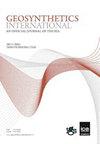土工格栅-土相互作用:影响荷载传递因素的试验分析
IF 3.3
2区 工程技术
Q2 ENGINEERING, GEOLOGICAL
引用次数: 3
摘要
通过透明土相互作用试验,研究了不同土工合成加筋界面处的荷载传递。微观相互作用性能的评估是根据动员拉伸载荷和界面剪切应力导致的土工合成材料和土壤之间的相对运动。分析了土工格栅孔径大小、抗拉刚度、土工格栅类型和配筋配置对荷载传递的影响。结果表明:随着土体变形的增大,摩擦对总荷载传递的贡献减小,横向肋的激活程度增大;随着土工格栅孔径与平均粒径之比的增大,界面剪应力减小,土工格栅荷载减小。随着钢筋抗拉刚度的增加,土工格栅的荷载会增加,但土工格栅和邻近土体的位移会减少。编织的PET和铺设的PP土工格栅的结果一致。在每根肋处有两个紧密间隔的横向构件的孔结构中,由于土壤颗粒受到额外的限制,获得了最有效的荷载传递。当土工格栅附着在非织造土工布上时,分离功能被启用,但由于颗粒-孔径相互作用减少,土工复合材料的增强性能降低。本文章由计算机程序翻译,如有差异,请以英文原文为准。
Geogrid-soil interaction: Experimental analysis of factors influencing load transfer
This paper presents interaction experiments with transparent soil to investigate the load transfer at the interface of different geosynthetic reinforcements. Microscopic interaction performance was evaluated in terms of mobilised tensile loads and interfacial shear stresses resulting from the relative movement between geosynthetic and soil. The effects of geogrid aperture size, tensile stiffness, geogrid type and reinforcement configurations on the load transfer were analysed. It was found that with increasing soil deformation, the contribution of friction to the total load transfer decreased and the transverse ribs were increasingly activated. The interfacial shear stresses were reduced as the ratio of geogrid aperture to mean particle size increased, resulting in lower geogrid loads. Higher geogrids loads were mobilised with increasing tensile stiffness of the reinforcement, but lower displacements of geogrid and adjacent soil occurred. Consistent results were found for woven PET and laid PP geogrids. The most effective load transfer was obtained for the aperture configuration with two closely spaced transverse members at each rib, as the soil particles were additionally confined. When the geogrid was attached to a nonwoven geotextile, the separation function was enabled, but the reinforcement performance of the geocomposite was lower due to reduced particle-aperture interaction.
求助全文
通过发布文献求助,成功后即可免费获取论文全文。
去求助
来源期刊

Geosynthetics International
ENGINEERING, GEOLOGICAL-GEOSCIENCES, MULTIDISCIPLINARY
CiteScore
6.90
自引率
20.00%
发文量
91
审稿时长
>12 weeks
期刊介绍:
An online only, rapid publication journal, Geosynthetics International – an official journal of the International Geosynthetics Society (IGS) – publishes the best information on current geosynthetics technology in research, design innovation, new materials and construction practice.
Topics covered
The whole of geosynthetic materials (including natural fibre products) such as research, behaviour, performance analysis, testing, design, construction methods, case histories and field experience. Geosynthetics International is received by all members of the IGS as part of their membership, and is published in e-only format six times a year.
 求助内容:
求助内容: 应助结果提醒方式:
应助结果提醒方式:


